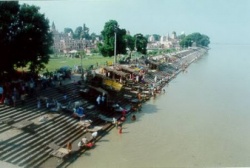Ayodhya
Ayodhya: Situated on the south bank of the river Ghagra or Saryu, Just 6 km from Faizabad, Ayodhya is a popular place of pilgrimage and temple cities long standing. This town is closely associated with Lord Rama, the seventh incarnation of Lord Vishnu. One of the seven most sacred cities of India, the ancient city of Ayodhya, according to the Ramayana, was founded by Manu, the law-giver of the Hindus. King Dasaratha ruled there peacefully for ten thousand years, and still had no son to succeed him.
After performing an elaborate Puja and Fire Offering to the Gods, his wife Kausalya gave birth to Lord Sri Rama, who the Lord Brahma had sent to earth as a human incarnation of the God Vishnu. In contemporary Hinduism, Rama, who is also called Ram, is often worshipped as God. For centuries, Ayodhya was the pride of the kings of the Surya or Ikshavaka dynasty, also known as the Raghuvansh, of which Lord Rama was the most celebrated king. With the Death of the last king of the Raghuvanshis, Ayodhya fell into decadence.
Today, Ayodhya has many beautiful temples, although practically nothing of that age remains in the city, and none of the ancient structures survive. Of the present temples, 35 are dedicated to Lord Shiva and 63 to Lord Vishnu.The place where Lord Rama was born is marked by a small temple. The site where, according to legend, Lord Rama was cremated, Lakshman Ghat and Sita Ghat is still visible, and there are also ancient earth mounds, Mani Parbat, identified with a Stupa built by Emperor Ashok and Sugriv Parbat, identified with an ancien monastery. Remnants of Hinduism, Buddhism, Jainism and Islam can still be found in Ayodhya. According to Jain tradition, five Tirthankaras were born at Ayodhya, including Adinath (Rishabhadeva) the 1st Tirthankar.
